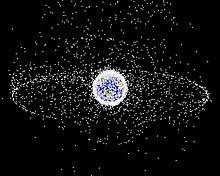
The Kessler syndrome (also called the Kessler effect,[1][2] collisional cascading, or ablation cascade), proposed by NASA scientists Donald J. Kessler and Burton G. Cour-Palais in 1978, is a scenario in which the density of objects in low Earth orbit (LEO) due to space pollution is numerous enough that collisions between objects could cause a cascade in which each collision generates space debris that increases the likelihood of further collisions.[3] In 2009, Kessler wrote that modeling results had concluded that the debris environment was already unstable, "such that any attempt to achieve a growth-free small debris environment by eliminating sources of past debris will likely fail because fragments from future collisions will be generated faster than atmospheric drag will remove them".[4] One implication is that the distribution of debris in orbit could render space activities and the use of satellites in specific orbital ranges difficult for many generations.[3]
- ^ Stenger, Richard (2002-05-03). "Scientist: Space weapons pose debris threat". CNN.com. Archived from the original on 2012-09-30. Retrieved 2011-03-17.
- ^ Olson, Steve (July 1998). "The Danger of Space Junk – 98.07". The Atlantic. Retrieved 2020-06-18 – via TheAtlantic.com.
- ^ a b Kessler, Donald J.; Cour-Palais, Burton G. (1978). "Collision Frequency of Artificial Satellites: The Creation of a Debris Belt" (PDF). Journal of Geophysical Research. 83 (A6): 2637–2646. Bibcode:1978JGR....83.2637K. doi:10.1029/JA083iA06p02637. Archived from the original (PDF) on 2011-05-15.
- ^ Cite error: The named reference
k09was invoked but never defined (see the help page).